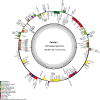Analysis of complete chloroplast genome sequences and insight into the phylogenetic relationships of Ferula L
- PMID: 36076164
- PMCID: PMC9461113
- DOI: 10.1186/s12864-022-08868-z
Analysis of complete chloroplast genome sequences and insight into the phylogenetic relationships of Ferula L
Abstract
Background: Ferula L. is one of the largest and most taxonomically complicated genera as well as being an important medicinal plant resource in the family Apiaceae. To investigate the plastome features and phylogenetic relationships of Ferula and its neighboring genera Soranthus Ledeb., Schumannia Kuntze., and Talassia Korovin, we sequenced 14 complete plastomes of 12 species. RESULTS: The size of the 14 complete chloroplast genomes ranged from 165,607 to 167,013 base pairs (bp) encoding 132 distinct genes (87 protein-coding, 37 tRNA, and 8 rRNA genes), and showed a typical quadripartite structure with a pair of inverted repeats (IR) regions. Based on comparative analysis, we found that the 14 plastomes were similar in codon usage, repeat sequence, simple sequence repeats (SSRs), and IR borders, and had significant collinearity. Based on our phylogenetic analyses, Soranthus, Schumannia, and Talassia should be considered synonymous with Ferula. Six highly divergent regions (rps16/trnQ-UUG, trnS-UGA/psbZ, psbH/petB, ycf1/ndhF, rpl32, and ycf1) were also detected, which may represent potential molecular markers, and combined with selective pressure analysis, the weak positive selection gene ccsA may be a discriminating DNA barcode for Ferula species.
Conclusion: Plastids contain abundant informative sites for resolving phylogenetic relationships. Combined with previous studies, we suggest that there is still much room for improvement in the classification of Ferula. Overall, our study provides new insights into the plastome evolution, phylogeny, and taxonomy of this genus.
Keywords: Chloroplast genome; Comparative analysis; Ferula; Phylogenetic relationships.
© 2022. The Author(s).
Conflict of interest statement
The authors declare that they have no competing interests.
Figures






Similar articles
-
The plastid genome of twenty-two species from Ferula, Talassia, and Soranthus: comparative analysis, phylogenetic implications, and adaptive evolution.BMC Plant Biol. 2023 Jan 5;23(1):9. doi: 10.1186/s12870-022-04027-4. BMC Plant Biol. 2023. PMID: 36604614 Free PMC article.
-
Thirteen complete chloroplast genomes of the costaceae family: insights into genome structure, selective pressure and phylogenetic relationships.BMC Genomics. 2024 Jan 17;25(1):68. doi: 10.1186/s12864-024-09996-4. BMC Genomics. 2024. PMID: 38233753 Free PMC article.
-
Complete chloroplast of four Sanicula taxa (Apiaceae) endemic to China: lights into genome structure, comparative analysis, and phylogenetic relationships.BMC Plant Biol. 2023 Sep 21;23(1):444. doi: 10.1186/s12870-023-04447-w. BMC Plant Biol. 2023. PMID: 37730528 Free PMC article.
-
Complete Chloroplast Genome Sequence of the Endemic and Endangered Plant Dendropanax oligodontus: Genome Structure, Comparative and Phylogenetic Analysis.Genes (Basel). 2022 Nov 4;13(11):2028. doi: 10.3390/genes13112028. Genes (Basel). 2022. PMID: 36360265 Free PMC article.
-
Dynamic evolution of the plastome in the Elm family (Ulmaceae).Planta. 2022 Dec 17;257(1):14. doi: 10.1007/s00425-022-04045-4. Planta. 2022. PMID: 36526857 Review.
Cited by
-
Maternal Donor and Genetic Variation of Lagerstroemia indica Cultivars.Int J Mol Sci. 2023 Feb 10;24(4):3606. doi: 10.3390/ijms24043606. Int J Mol Sci. 2023. PMID: 36835020 Free PMC article.
-
Creating an effective DNA identification system for discriminating cherries (Prunus subgenus Cerasus).BMC Plant Biol. 2025 Apr 15;25(1):475. doi: 10.1186/s12870-025-06328-w. BMC Plant Biol. 2025. PMID: 40234750 Free PMC article.
-
Complete chloroplast genomes of Cerastium alpinum, C. arcticum and C. nigrescens: genome structures, comparative and phylogenetic analysis.Sci Rep. 2023 Oct 31;13(1):18774. doi: 10.1038/s41598-023-46017-y. Sci Rep. 2023. PMID: 37907682 Free PMC article.
-
The Main Medicinal Plants in Arid Regions of Uzbekistan and Their Traditional Use in Folk Medicine.Plants (Basel). 2023 Aug 15;12(16):2950. doi: 10.3390/plants12162950. Plants (Basel). 2023. PMID: 37631161 Free PMC article.
-
The Complete Chloroplast Genomes of Gynostemma Reveal the Phylogenetic Relationships of Species within the Genus.Genes (Basel). 2023 Apr 17;14(4):929. doi: 10.3390/genes14040929. Genes (Basel). 2023. PMID: 37107687 Free PMC article.
References
-
- Pimenov MG, Leonov MV. The genera of the Umbelliferae: a nomenclator. Kew: Royal Botanic Gardens; 1993.
-
- Sina AA. Kanon vrachebnoy nauki (Canon). In: Zaxidov TZ, editor. Book. 1. Tashkent: Academy of Sciences of the UzSSR; 1954. p. 549.
-
- Shen GM. Chinese herbal medicine series: Ferula. Urumqi: Xinjiang people’s publishing house; 1986.
MeSH terms
Grants and funding
- FZ-20200929321/Taxonomic revision of polymorphic plant families of the flora of Uzbekistan
- Grant No.2021xjkk0600/The work was supported by the Third Xinjiang Scientific Expedition Program
- 2019FY100204/the National Science and Technology Basic Program of China
- 2021E01020/the Shanghai cooperation organization partnership and international technology cooperation plan of science and technology projects
- No. 2019429/Youth Innovation Promotion Association Foundation of the Chinese Academy of Sciences, China
LinkOut - more resources
Full Text Sources

